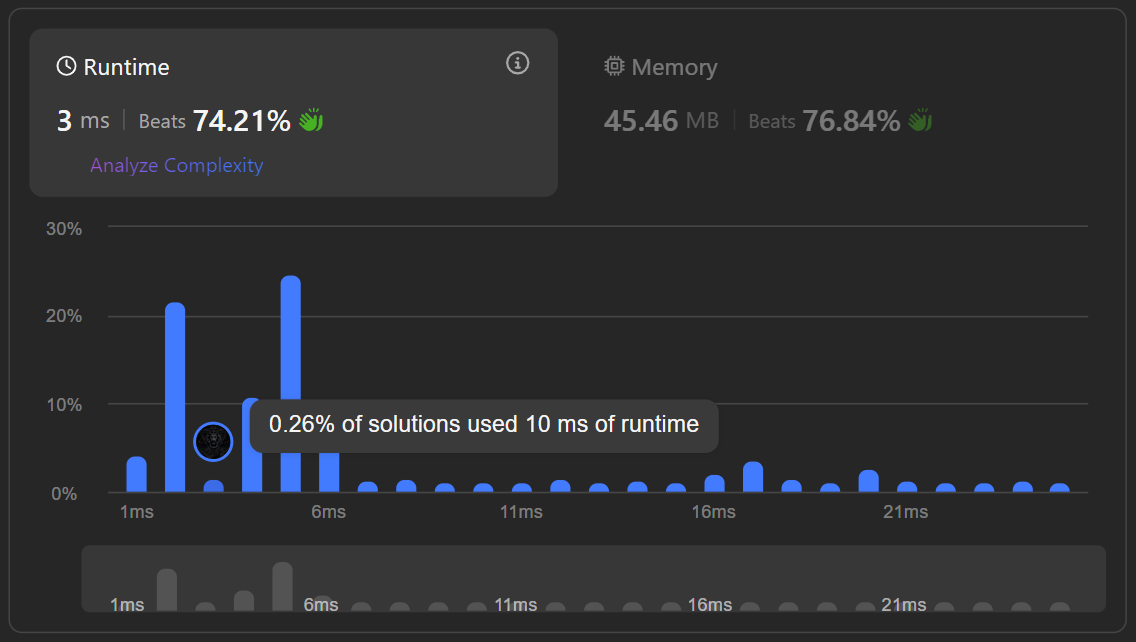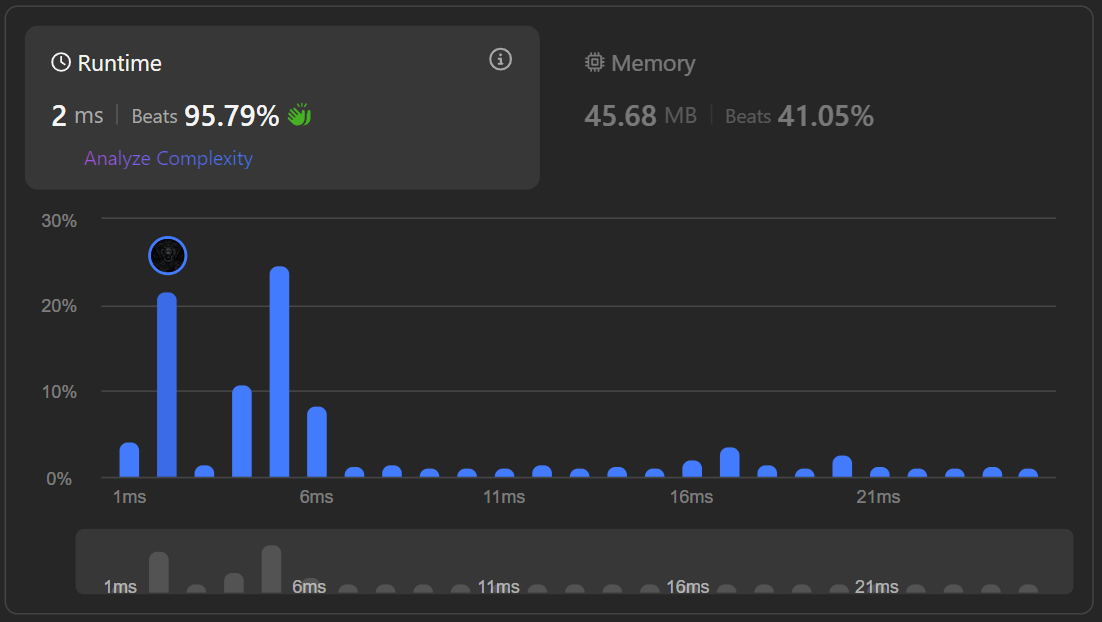2657. Find the Prefix Common Array of Two Arrays
2657. Find the Prefix Common Array of Two Arrays
[Problem]
Hash Table Array Bit Manipulation
Intuition
Given two 0-indexed integer permutations
AandBof lengthn, we aim to find a prefix common arrayC.The problem essentially requires us to track common elements between the prefixes of
AandBas we iterate through the arrays. The challenge lies in efficiently keeping track of these common elements.We know that the there are
nelements from1tonthat all appear once.
Tips:
- Leverage the Range of Numbers:
- When the numbers are restricted to a specific range, such as
1 to n, consider using arrays or bit manipulation to efficiently track and count occurrences. - Avoid over-complicating with data structures like
Setunless absolutely necessary, we will discuss how the set approach works slower compared to the BitSet or Frequency array approach in this scenario.
- When the numbers are restricted to a specific range, such as
- Utilize Small Constraints:
- Analyze the constraints carefully. For instance, in this problem:
n <= 50: A small constraint allows more flexibility in choosing approaches, including less optimized ones.- Try to use constant-sized data structures like
Arrayswork well for small ranges. - A BitSet uses individual bits (
0or1) to represent whether element is present or absent, making it memory-efficient compared to other data structures likeSet.
- Analyze the constraints carefully. For instance, in this problem:
- Optimize Space Usage:
- If the constraint ensures a small range, you can often replace sets or hash maps with arrays to save space and improve runtime.
- For example, replacing a
Setwith a frequency array (or BitSet also in this case) is a common optimization.
Approach
1. Using HashSet
- Maintain two sets,
setAandsetB, to store elements seen so far inAandB. - At each index
i, count the number of elements insetAthat also exist insetB. - Update the result array
Cwith this count.
Code
1
2
3
4
5
6
7
8
9
10
11
12
13
14
15
16
17
18
19
20
21
22
23
24
25
26
class Solution {
public int[] findThePrefixCommonArray(int[] A, int[] B) {
int n = A.length;
int[] C = new int[n]; // result array
Set<Integer> setA = new HashSet<>(); // track elements seen in A
Set<Integer> setB = new HashSet<>(); // track elements seen in B
for (int i = 0; i < n; i++) {
setA.add(A[i]); // add current element from A to setA
setB.add(B[i]); // add current element from B to setB
int common = 0; // counter for common elements
// count common elements between setA and setB
for (int elemA : setA) {
if (setB.contains(elemA)) {
common += 1;
}
}
C[i] = common;
}
return C;
}
}
2. Using BitSet
- Use a
BitSetto efficiently track the presence of elements. - Represent elements from
AandBusing specific bit positions: odd forA[i]and even forB[i]. - Check if the bits are set and increment
commonaccordingly. - More about BitSet
Index Mapping
- For an element
x:- Odd index (
2 * x - 1): Tracks ifxhas been seen in arrayA. - Even index (
2 * x): Tracks ifxhas been seen in arrayB.
- Odd index (
- This mapping creates a predictable pattern for bit positions, as shown below:
| Element (x) | Bit Index for A (2x-1) | Bit Index for B (2x) |
|---|---|---|
| 1 | 1 | 2 |
| 2 | 3 | 4 |
| 3 | 5 | 6 |
| 4 | 7 | 8 |
| … | … | … |
- An example is below
1
2
3
4
5
6
7
8
9
10
11
For e.g.
A1 B1 A2 B2 A3 B3 A4 B4
index => 0 1 2 3 4 5 6 7 8
bitset => 0 1 1 1 0 1 0 1 1
A1 : 1 in array A | B1 : 1 in array B
A2 : 2 in array A | B2 : 2 in array B
=> Interpretation: If bit at B2(index 4) is `0` means 2 has NOT been seen in the array `B`, vice-versa for `1`.
- Dry running an example:
1
2
3
4
5
6
7
8
9
10
11
12
13
14
15
16
17
18
19
20
21
22
23
24
For `A = [1, 2, 3]` and `B = [3, 1, 2]`:
Start
------------------------------------------------
i=0
- `A[0] = 1`: Set bit `1` (odd).
- `B[0] = 3`: Set bit `6` (even).
------------------------------------------------
i=1
- `A[1] = 2`: Set bit `3` (odd).
- `B[1] = 1`: Set bit `2` (even); bit `1` (odd) is already set (common element).
------------------------------------------------
i=2
- `A[2] = 3`: Set bit `5` (odd); bit `6` (even) is already set (common element).
- `B[2] = 2`: Set bit `4` (even); bit `3` (odd) is already set (common element).
------------------------------------------------
Output
C = [0, 1, 3]
Code
1
2
3
4
5
6
7
8
9
10
11
12
13
14
15
16
17
18
19
20
21
22
23
24
25
26
27
28
29
30
31
class Solution {
public int[] findThePrefixCommonArray(int[] A, int[] B) {
int n = A.length;
int[] C = new int[n]; // result array
// BitSet to track seen elements (size 2*50 + 1), constraints specify max length is 50
BitSet bs = new BitSet(101);
int common = 0; // counter for common elements
for (int i = 0; i < n; i++) {
int aa = A[i]; // current element from A
int bb = B[i]; // current element from B
// mark A[i] in BitSet (odd index)
bs.set((2 * aa) - 1);
if (bs.get(2 * aa)) { // check if B[i] already set
common++;
}
// Mark B[i] in BitSet (even index)
bs.set(2 * bb);
if (bs.get((2 * bb) - 1)) { // check if A[i] already set
common++;
}
C[i] = common;
}
return C;
}
}
3. Using Frequency Array
- Use a frequency array to count occurrences of elements in both
AandB. - Whenever an element’s frequency becomes 2 (it means that element appeared in both arrays), increment
common.
Code
1
2
3
4
5
6
7
8
9
10
11
12
13
14
15
16
17
18
19
20
21
22
23
24
25
26
class Solution {
public int[] findThePrefixCommonArray(int[] A, int[] B) {
int n = A.length;
int[] C = new int[n]; // result array
int[] freq = new int[n + 1]; // frequency array to track element occurrences
int common = 0; // counter for common elements
for (int i = 0; i < n; i++) {
// increment frequency for A[i]
freq[A[i]]++;
if (freq[A[i]] == 2) { // element appears in both arrays
common++;
}
// increment frequency for B[i]
freq[B[i]]++;
if (freq[B[i]] == 2) { // element appears in both arrays
common++;
}
C[i] = common;
}
return C;
}
}
Complexity Analysis
| Approach | Time Complexity | Space Complexity | Runtime |
|---|---|---|---|
| Using Set | O(n²) | O(n) |  |
| Using BitSet | O(n) | O(1) |  |
| Using Frequency Array | O(n) | O(n) |  |
Full Code
1
2
3
4
5
6
7
8
9
10
11
12
13
14
15
16
17
18
19
20
21
22
23
24
25
26
27
28
29
30
31
32
33
34
35
36
37
38
39
40
41
42
43
44
45
46
47
48
49
50
51
52
53
54
55
56
57
58
59
60
61
62
63
64
65
66
67
68
69
70
71
72
73
74
75
76
77
78
79
80
81
82
83
84
85
86
87
88
89
90
91
class Solution {
public int[] findThePrefixCommonArray(int[] A, int[] B) {
// uncomment the approach you want to use
// return usingSet(A, B);b
// return usingBitSet(A, B);
return usingFrequencyArray(A, B);
}
// approach 1: Using Set
private int[] usingSet(int[] A, int[] B) {
int n = A.length;
int[] C = new int[n]; // result array
Set<Integer> setA = new HashSet<>(); // track elements seen in A
Set<Integer> setB = new HashSet<>(); // track elements seen in B
for (int i = 0; i < n; i++) {
setA.add(A[i]); // add current element from A to setA
setB.add(B[i]); // add current element from B to setB
int common = 0; // counter for common elements
// count common elements between setA and setB
for (int elemA : setA) {
if (setB.contains(elemA)) {
common += 1;
}
}
C[i] = common;
}
return C;
}
// approach 2: using BitSet
private int[] usingBitSet(int[] A, int[] B) {
int n = A.length;
int[] C = new int[n]; // result array
// BitSet to track seen elements (size 2*50 + 1), constraints specify max length is 50
BitSet bs = new BitSet(101);
int common = 0; // counter for common elements
for (int i = 0; i < n; i++) {
int aa = A[i]; // current element from A
int bb = B[i]; // current element from B
// mark A[i] in BitSet (odd index)
bs.set((2 * aa) - 1);
if (bs.get(2 * aa)) { // check if B[i] already set
common++;
}
// Mark B[i] in BitSet (even index)
bs.set(2 * bb);
if (bs.get((2 * bb) - 1)) { // check if A[i] already set
common++;
}
C[i] = common;
}
return C;
}
// approach 3: using frequency array
private int[] usingFrequencyArray(int[] A, int[] B) {
int n = A.length;
int[] C = new int[n]; // result array
int[] freq = new int[n + 1]; // frequency array to track element occurrences
int common = 0; // counter for common elements
for (int i = 0; i < n; i++) {
// increment frequency for A[i]
freq[A[i]]++;
if (freq[A[i]] == 2) { // element appears in both arrays
common++;
}
// increment frequency for B[i]
freq[B[i]]++;
if (freq[B[i]] == 2) { // element appears in both arrays
common++;
}
C[i] = common;
}
return C;
}
}
This post is licensed under CC BY 4.0 by the author.
